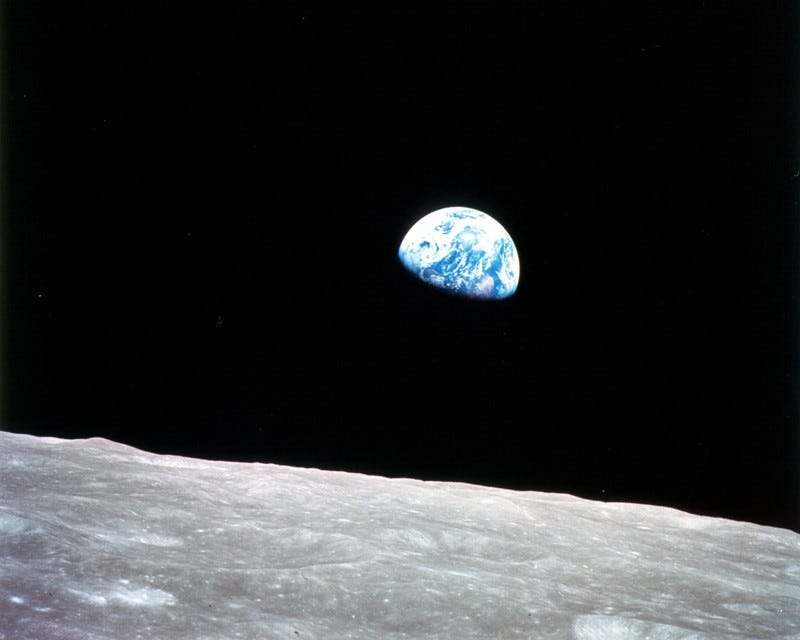A Reflection on Earthrise: Cherishing Our Planet
Written on
Chapter 1: The Importance of Earth
The planet we inhabit deserves our utmost care and respect. It's time we start acting in accordance with that belief.

Credit: NASA
Apollo 11 is perhaps the most renowned of the Apollo missions. The phrase “The Eagle has landed” marked an extraordinary achievement. Neil Armstrong, Buzz Aldrin, and Michael Collins became icons of the Space Race. My father, just eight years old when the U.S. made history by landing on the Moon, was captivated by the event. July 20, 1969, remains etched in his memory.
While I envy my father's experience of witnessing Armstrong's famous step live, another mission resonates with me even more: Apollo 8. This mission arguably holds the most significance in the context of the Space Race. As noted by Steve Dent of Engadget, “The 1968 Apollo 8 mission was crucial in the race to get a man on the moon. It was the first manned launch of the colossal Saturn V rocket, which had only flown twice before in unmanned test flights. It also marked the first time a manned spacecraft escaped Earth’s gravity and orbited another celestial body.”
Simply put, it was monumental.
During the mission’s lunar orbit on December 24, 1968, Commander Frank Borman, alongside Bill Anders and Jim Lovell, captured a remarkable moment. On their fourth orbit, Borman turned the command module and caught a glimpse of Earth rising over the lunar horizon. Anders, sensing the moment's beauty, insisted on using color film for the shot. Their conversation revealed the excitement of the occasion:
Anders: "Oh my God! Look at that picture over there! There’s the Earth coming up. Wow, that’s pretty."
Borman: (teasing) "Hey, don’t take that; it’s not scheduled."
Anders: (laughs) "You got a color film, Jim? Hand me that roll of color quick, would you…"
Lovell: "Oh man, that’s great!"
Anders took several photos to ensure they captured this gem. When they returned on December 27, NASA's chief photographer, Dick Underwood, developed their seven rolls, totaling 865 frames. The outcome was nothing short of spectacular. We now refer to it as Earthrise, and it stands as my favorite photograph.
Why Earthrise Holds a Special Place in My Heart:
Earthrise was not the first image of Earth taken from lunar orbit; that honor goes to Lunar Orbiter 1, which produced a similar black-and-white photograph. However, the view of our tiny blue planet surrounded by an infinite void is breathtaking in comparison.
For those who may not recall the Space Race, it can be difficult to grasp the profound impact that viewing Earth from space had on people. Born a quarter-century later, I can only rely on the insights of those who experienced it firsthand, including Anders, the photographer.
From The School Of Life: “Earthrise allowed us to feel a kind of care, even love, for the planet. Viewed from space, we see it protected from relentless bombardments of meteorites and rays, made habitable by a delicate atmosphere — one that we are now entirely responsible for preserving. Our oxygen-rich atmosphere — the distinguishing factor between a barren planet like Mars and our lush, breathable home — appears as a faint halo in the photograph. From this vantage point, it becomes easier to feel compassion towards humanity and to appreciate our existence. In the face of such beauty, our flaws seem to fade, prompting us to be more patient and kind towards our fellow beings navigating the vast universe together.”
In the book Life’s 100 Photographs that Changed the World, renowned wilderness photographer Galen Rowell referred to Earthrise as “the most influential environmental photograph ever taken.” Although its importance didn’t immediately resonate, NASA commemorated it on a stamp, and publications like Time and Life showcased it as a defining image of the era, as reported by The Guardian two years ago.
“It gained this iconic status,” Anders reflected. “People realized that we lived on this fragile planet and that we needed to take care of it.”
Following the Earthrise photo, humanity experienced some of the most significant environmental advancements in history. In the United States alone, the Environmental Protection Agency was established, Earth Day was inaugurated, and vital legislation like the NEPA, Clean Air Act, Clean Water Act, and Endangered Species Act were enacted. Less than four years after the photo was taken, the United Nations held its first world conference focused on environmental issues in Stockholm.
Chapter 2: Keeping the Spirit of Earthrise Alive
Two years ago, Anders reminisced about the Apollo 8 mission and the iconic photograph he captured as its fiftieth anniversary approached. You can explore his insightful reflections here.
In the absence of uplifting global reminders of our shared humanity and the preciousness of our home, we must strive to maintain the spirit of Earthrise. We have yet to fully comprehend the gift of life on Earth, and if we continue to take it for granted, we may lose the opportunity to appreciate it fully.
As The School Of Life emphasized, we have the capability to harm our atmosphere now more than ever, especially since most greenhouse gases emitted since Earthrise were released after the photo was taken.
Yet, we do not have to destroy this planet. The Earth is worth defending. It is a magnificent place, the only home we have ever known, and the only one we will ever need.
We are fortunate to inhabit it. It’s time we start acting like it.